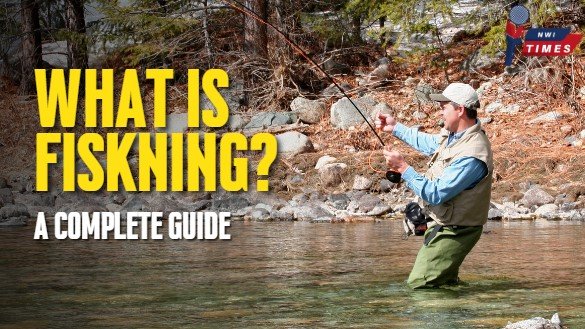Fiskning is a Swedish term for fishing, a popular activity enjoyed by many people around the world. It involves catching fish from bodies of water like rivers, lakes, or the ocean. Fiskning is not just a way to get food; it is also a hobby that many find relaxing and rewarding.
Some people do it for sport, while others fish to spend time in nature. Fishing has been part of human life for thousands of years. Over time, different methods and tools have been developed to make fiskning easier and more efficient.
Why Do People Love Fiskning?
Fiskning is loved by many for various reasons. First, it provides a chance to relax and unwind. Being out in nature, away from the hustle and bustle of daily life, helps people feel calm and refreshed. Second, fiskning is a great way to spend time with friends and family.
Whether it’s a quiet day on the lake or a fun competition to see who catches the most fish, fiskning brings people together. Lastly, catching a fish gives a sense of achievement.
Many people feel proud when they catch a big fish, especially if it’s their first time. Fiskning offers both the excitement of the catch and the peace of being in nature.
What Are the Different Types of Fiskning?
There are several types of fiskning, each with its own methods and equipment. One common type is freshwater fishing, where people fish in rivers, lakes, or ponds. This type of fiskning often involves using a fishing rod and bait to lure fish.
Another type is saltwater fishing, which takes place in oceans or seas. In this case, the equipment might be different, as saltwater fish are usually larger and stronger. Fly fishing is another popular type, where a special kind of bait called a fly is used.
The technique for casting the line is different in fly fishing, making it a unique challenge. Ice fishing is also popular in colder regions, where people cut holes in frozen lakes to catch fish. Each type of fiskning offers a different experience and requires different skills.
How Can Beginners Start Fiskning?
For those new to fiskning, starting can seem overwhelming, but it’s easier than it looks. The first step is choosing the right equipment. A basic fishing rod, some hooks, and bait are usually enough for beginners.
It’s also important to pick a good spot for fishing, like a local pond or river known to have fish. Beginners should start with simple techniques, like casting a line and waiting for a bite. Patience is key in fiskning; sometimes, it takes a while to catch something.
Learning from more experienced fishers or taking a beginner’s class can also help. Over time, beginners will learn the tricks of the trade and start catching fish more easily.
What Are the Best Places for Fiskning?
The best places for fiskning vary depending on the type of fish you want to catch and the environment you prefer. For freshwater fiskning, lakes and rivers are popular spots. Some well-known lakes for fishing include the Great Lakes in the United States and Canada, and Lake Victoria in Africa.
Rivers like the Amazon and the Mississippi are also famous for their fish. For saltwater fiskning, the ocean is the place to go. Coastal areas like the Gulf of Mexico and the Caribbean Sea are known for their rich marine life.
If you prefer ice fishing, places with cold climates, like Alaska or northern Canada, offer great opportunities. Each location offers a unique fiskning experience, whether you’re looking for a calm lake or a deep-sea adventure.
What Are the Benefits of Fiskning?
Fiskning offers many benefits beyond just catching fish. One of the biggest benefits is the relaxation it provides. Spending time outdoors, surrounded by nature, helps reduce stress and anxiety. Fiskning also encourages patience and focus, as it often requires waiting and staying still.
This makes it a great way to practice mindfulness. Another benefit is the physical activity involved. Whether you’re casting a line or rowing a boat, fiskning keeps you active and engaged.
Finally, fiskning can be a social activity, bringing people together. It’s a great way to bond with friends and family or meet new people who share the same interest.
Table: Pros and Cons of Fiskning
| Pros of Fiskning | Cons of Fiskning |
| Relaxation and stress relief | Can be time-consuming |
| Opportunity to spend time in nature | Requires patience and sometimes long waits |
| Physical activity and exercise | Can be costly with specialized equipment |
| Social activity, good for bonding | Weather conditions can affect the experience |
| Sense of achievement when catching fish | Environmental impact if not done responsibly |
What Are the Environmental Considerations of Fiskning?
Fiskning has an impact on the environment, which is why it’s important to fish responsibly. Overfishing, where too many fish are caught, can harm fish populations and disrupt the ecosystem. Some species may become endangered if they are caught too often.
It’s also important to avoid leaving trash or fishing lines in the water, as these can harm wildlife. Many places have rules about the number of fish you can catch or the size of the fish you can keep.
These rules are in place to protect fish populations and ensure that fiskning remains sustainable. By following these rules and fishing responsibly, we can enjoy fiskning without harming the environment.
How Has Fiskning Evolved Over Time?
Fiskning has a long history, dating back thousands of years. In ancient times, people fished with simple tools like spears and nets. Over time, fiskning techniques and equipment became more advanced.
The fishing rod, for example, has evolved from a simple stick to a sophisticated tool made from materials like fiberglass and carbon fiber. Modern technology has also changed fiskning. Today, fishers use sonar devices to locate fish and GPS to find the best fishing spots.
Commercial fiskning has also grown, with large boats and nets catching fish in massive quantities. While these advancements have made fiskning more efficient, they have also raised concerns about overfishing and environmental impact. Despite these changes, the basic principles of fiskning—patience, skill, and respect for nature—remain the same.
What Is the Future of Fiskning?
The future of fiskning will likely see more focus on sustainability and environmental protection. As concerns about overfishing and climate change grow, more people are becoming aware of the need to fish responsibly.
This could lead to stricter regulations on fiskning and more efforts to protect fish habitats. At the same time, technology will continue to play a role in fiskning. New tools and devices will make it easier to find and catch fish, but they must be used responsibly.
The rise of catch-and-release fishing, where fish are caught and then released back into the water, is one example of how fiskning is evolving. This practice helps protect fish populations while still allowing people to enjoy the sport. In the future, fiskning will likely continue to be a popular activity, but with a greater emphasis on sustainability.
Conclusion
Fiskning is more than just a way to catch fish; it’s a time-honored activity that brings joy, relaxation, and a sense of connection to nature. Whether you’re a beginner learning the basics or an experienced angler seeking the perfect catch, fiskning offers something for everyone.
The various types of fiskning, from freshwater to saltwater, each provide unique experiences that cater to different interests and skills.
While it’s important to recognize the environmental impact of fiskning, responsible practices and sustainable techniques can help preserve this beloved activity for future generations. As fiskning continues to evolve, it remains a cherished tradition that enriches our lives, fosters social connections, and deepens our appreciation for the natural world.



